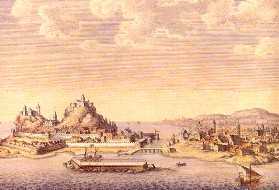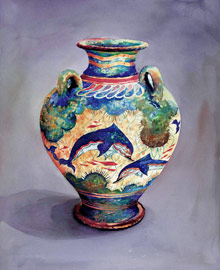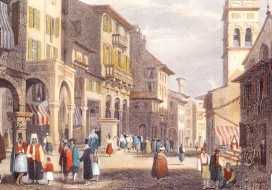Corfu | Hotels | Corfu villas | Apartments | Car hire | Flights | Corfu airport | Ferries | Transfers | Corfu weather
History of Corfu - Discover the fascinating Corfu GREECE history
Corfu is mentioned frequently in Greek Mythology. The modern Greek name Kerkyra comes from the nymph who was the daughter of the river-god Asopus. Posideon, the god of the sea fell in love with her and made love to her on the island, giving birth to the race of the Phaeaceans.
The name of Corfuis also tied in with the demonic deity Gorgyra or Gorgo, perhaps a mythological predecessor of Artemis whose image can be found on a pediment on the ancient temple to Artemis. The name Corfu comes from the word coryphi, which means peak and was used for the acropolis of the capital city. The name Kerkyra is only used in Greece. To the rest of the world the island is known as Corfu. |
|
In the Odyssey, the hero Odysseus is washed ashore with the help of the Goddess Athena and awakens to the laughter of princess Nausica and her friends washing clothes in a nearby stream. He was taken home to the Phaecian Palace and after revealing his identity to King Alcinous he is given a ship to take him safely to Ithaka. However during the return trip the Phaecian ship is turned to stone by the God Posideon who was angry at them for helping Odysseus. Jason and the Argonauts also visited here with the Golden Fleece and it was here that he married Media. Artifacts from the Paleolithic period (30,000 to 7,000BC) have been found in a cave at Gardiki in the southwest part of Corfu island. There is also evidence of habitation from the Mesolithic period and several Neolithic (6000-2600 BC) settlements have been found including an important one near Sidari. During the Geometric period the Illyrians inhabited the island, sometime before the 8th Century BC. The Greeks did not arrive until around 750 BC, a colony from the city of Eretria on the island of Evia. Corfu supplied the Eretrians with lumber for ships and became an important stepping stone to the west. In 734 BC the Eretrians were driven out by the Corinthians who brought great wealth and culture to the island as well as the first of many colonies at Croton in southern Italy.
|
But in 664 Corfu fought with her mother city of Corinth in what Thucydides described as the first sea battle in Greek history. It was not the last battle between the two cities who were at odds over economic matters for centuries. In the late seventh century BC, Periander, tyrant of Corinth succeeded in conquering the island but this began a period of extensive building and creativity, including the construction of the temple of Artemis at Agia Theodori and cenotaph of Menecrates. The island prospered with trade and by the end of the 7th Century was minting its own coins and has a population of over 10,000 people |
|
During the Persian wars of the fifth century, Corfu had a fleet second only to Athens. They sent a fleet of 60 ships to the battle of Salamis but according to Herodotus they took their time about getting there to avoid the battle and were criticized by the Athenians. In 431 BC it was over yet another dispute between Corfu and Corinth that led to the Peloponesian wars which was the World War II of it's time with all the city-states of Greece taking the side of either Athens or Sparta, when the Athenians backed Corfu and the Corinthians sided with Sparta. The island lost half its population in these wars and eventually fell to the Spartans. In 229 it was invaded and conquered by pirates
|
|
They in turn were driven out by the Romans who gave the island autonomy provided they were allowed to use it as a naval base. Nero, Julius Caesar, Vespacion and Cicero all visited the island and many wealthy Romans had estates here. The Roman influence lasted from 229 to 395AD. There are still Roman ruins on the island. From 395 to 1267 Corfu was part of the Byzantine Empire and frequent raids by the Goths, Vandals and Saracens caused the inhabitants to move to the high places of the city which could be easily defended. It was captured by the Normans in 1081, lost and recaptured several times. When the forces of the Fourth Crusade captured Constantinople in 1204, Corfu was ceded to Venice. |
But then years later Corfu was Greek again when Michael Angelus Ducas set up the Despotate of Epirus, one of three independent Greek states. During this period Angelokastro was fortified as defense against pirates in the northern part of the island. The island was later given to Manfred the Prince of Achai and King of Two Sicilies as part of the dowry of the daughter of Michael The Second. Then it passed to the Angevin dynasty of Naples who installed Latin priests in the churches, removing the Byzantine clergy.
In 1402 the Venetians purchased the island from Naples. This is known as the Second Period of Venetian rule and it lasted until 1797. This was probably the most important period for the island, not only because of the economic progress and the building that went on but also because it was during this period that the rest of Greece fell under the domination of the Ottoman Turks. The island became a fortress and the base of the admiral of the Venetian fleet. Corfu was attacked frequently by the Genovese and of course by the Turks . In 1537 Barbarossa, a pirate in the service of Sultan Sulieman the Magnificent laid siege to the town with 25,000 troops. The Corfiots drove Barbarossa off and he was recalled to Constantinople taking with him thousands of prisoners who were sold into slavery.
After several other attacks by the Turks, the Venetians decided to build the New Fortress and strengthen the existing walls of the city. Because of this, and some say divine intervention by Saint Spyridon, the Ottoman fleet was finally driven off in a battle that is celebrated every year on August 11th. During the period of Venetian rule the island became a haven and place of refuge for many scholars and artists escaping the Turkish occupied mainland and thus helped make the island one of the most culturally developed regions in the east.
When Napoleon overthrew the Venetians and the French occupied the island in 1797 the Corfiots welcomed them with enthusiasm believing that because of the French revolution the lower classes would be treated better. But this was not the case. The French imposed heavy taxes on the people though they did introduce a system of primary education and a printing house. But two years later a combined Russian and Turkish fleet captured the island after four months of fighting and Corfu became the capital of the Septinsular Republic which included all the Ionian islands. Then in 1807 when Russia and France signed the treaty of Tilsit, Corfu and the other islands became provinces of Napolean. This time around the French took more of an interest in the intellectual and economic development of the island and founded the Ionian Academy, constructing new buildings and introducing new crops like potatoes and tomatoes.
When Napoleon fell in 1814 Corfu was placed under the protection of the British. Ioannis Capodistrias submitted a proposal at the congress of Vienna which he hoped would grant independence to the island but Britain, Austria and Prussia vetoed it. But during the Congress of Paris he was more successful and the Treaty of 1815 created a United States of the Ionian Islands with Corfu as its capital, administered under a British High Commissioner. In 1848, after years of British oppression, Capodistrias was able to pass a revised constitution that granted freedom of the press which led immediately to the publication of the first newspaper in Corfu, Greek was recognized as the official language and a new system of education was set up. In 1824 the first Greek university, the Ionian Academy, was set up. Despite the tension between the British and the Corfiots, the years of British rule was responsible for the building of the roads and the creation of the island's water supply.
The Ionian islands did not become a part of Greece until 1864 even though Ioannis Capodistrias was elected the first President of Greece in 1827 and assassinated in 1831. Corfu was declared neutral territory but was invaded by French and Serbian forces in World War I, bombed by the Italians in 1923 and again during World War II and was bombed and occupied by the Germans until the war's end |
Corfu | Corfu map | Getting to Corfu | Accommodation | Greece | Greece map | Aqualand | Advertise | Contact
 © corfutoday.com - Corfu history information
© corfutoday.com - Corfu history information
All Rights Reserved. No part of this web site may be reproduced without permission
|
|




